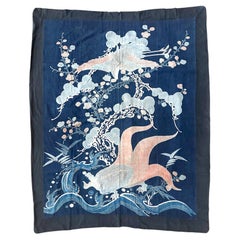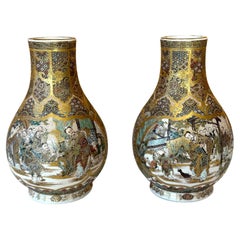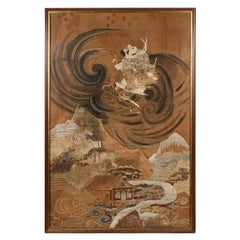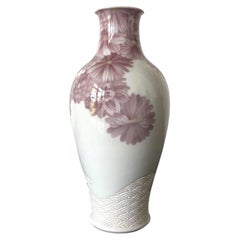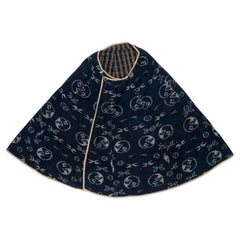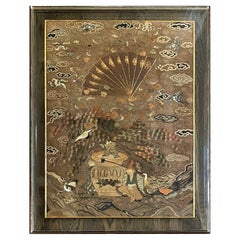TISHU Furniture
21
to
21
21
21
21
1
147
309
588
101
154
191
175
21
4
17
12
28
43
49
69
30
25
13
8
8
4
3
19
18
18
2
2
1
1
1
Period: 1890s
Antique Large Japanese Futon Cover with Resist Yuzen Dye
Located in Atlanta, GA
A large unframed Japanese Futonji textile art circa late 19th century toward the end of the Meiji period. Seamed together from four vertical sections of cotton in deep indigo color, ...
Category
Antique 1890s Japanese Meiji Textiles
Materials
Cotton
Pair of Fine Miniature Satsuma Vase with Moriage Enamel Decoration by Seikozan
Located in Atlanta, GA
A pair of small ceramic vases with superb surface decorations made by Japanese studio Seikozan circa 1890-1910s (late Meiji Period). One of the many artist studios that specialized i...
Category
Antique 1890s Japanese Meiji Ceramics
Materials
Ceramic
Framed Japanese Antique Embroidery Sennin Tapestry Meiji Period
Located in Atlanta, GA
A stunning Japanese embroidery tapestry circa 1880s-1900s from late Meiji period, presented with an original wood frame with inner gold trim. The tour-de-force embroidered tapestry s...
Category
Antique 1890s Japanese Meiji Textiles
Materials
Giltwood, Silk
Japanese Ceramic Vase with Delicate Carvings by Makuzu Kozan Meiji Period
By Makuzu Kozan
Located in Atlanta, GA
A delicate and rare Japanese ceramic vase by the important Meiji imperial potter Makuzu Kozan (1842-1916) circa 1887-1910. Dated to his underglaze phase post 1887 after he successful...
Category
Antique 1890s Japanese Japonisme Ceramics
Materials
Ceramic
Japanese Indigo Kasuri Ikat Traveling Cape
Located in Atlanta, GA
Known in Japanese as Bozugappa (priest's raincoat), this cape-like garment was worn by the travelers in Japan circa late 19th century to early 20th century (end of Meiji period). Derived from the cape worn by the Portuguese missionary, who first arrived in Japan in mid-16th century, this type of cape was originally reserved for the Japanese military...
Category
Antique 1890s Japanese Meiji Textiles
Materials
Cotton, Linen
Japanese Silk Embroidery Tapestry Meiji Period
Located in Atlanta, GA
A spectacular Japanese embroidered silk panel beautifully presented in a gilt frame suspended in a lucite shadow box with gilt wood border. The silk picture is dated to 1890-1910s toward the end of Meiji Period, when Japanese started to participate international expose by presenting its best art and craft. Elaborate embroidered silk tapestry like this was very popular among westerners due to its superb craftmanship and also exotic subject matter that was often derived from classic Japanese folklore, mythology and various motifs. The tapestry on offer is such an example. It depicts an old couple...
Category
Antique 1890s Japanese Japonisme Textiles
Materials
Fabric, Silk, Lucite
Large Framed Japanese Embroidery Dragon Tapestry
Located in Atlanta, GA
An impressive Japanese embroidery tapestry circa 1890s Meiji period, presented with brocade border on linen canvas in a Lucite shadow box. The stunning design features three dragons coiling and flying in the clouds. The high relief technique used to render the dragons using mostly the silver threads gives this piece a tremendous sense of motion. The most auspicious mythological creature in Japan and China, dragons were a very popular motif in textile art. In this particular piece, it is the impressive size, the superb craftsmanship, the profuse use of silver threads and near perfect condition that set it apart. Japanese Meiji textiles were widely exhibited in the west during turn of the 20th century at the international exposition. It was used to showcase the Japanese aesthetics with the techniques at their pinnacle. These expositions solidified the country's images overseas and felled the Japanese craze in the west, which turned out to be a long-lasting influence on the western art. Many pieces were purchased and stayed in the west. It is likely this estate piece was from one of the expositions based on its high quality.
For two similar dragon tapestries...
Category
Antique 1890s Japanese Japonisme Textiles
Materials
Textile, Lucite
A stack of six antique wood trays with bone inlays
Located in Atlanta, GA
A fantastic set of six antique trays that fit into a stack, likely from British India turn of the 20th century. The wood is likely rosewood with attractive grains and the trays are i...
Category
Antique 1890s Indian British Colonial Serving Pieces
Materials
Wood, Bone
Antique Navajo Chief Blanket
Located in Atlanta, GA
Sometimes categorized as the fourth-phase chief blanket, this wonderful piece of Navajo textile art is well preserved and can be dated to 1890-1910. Wov...
Category
Antique 1890s American Navajo Native American Objects
Materials
Wool
Japanese Ceramic Vase by Ito Tozan I Meiji Period
By Ito Tozan I
Located in Atlanta, GA
This stoneware vase of a jar form was finely decorated with low relief carving and delicate colored glazes depicting bundles of peony flowers. It was made by Ito Tozan I (1846-1920) circa 1890-1900s in the late Meiji Period. The color pallet was both bold and subtle, with dark green and rusty leaves with golden outlines and white and light yellow peony petals covering much of the surface. Impressed with potter's mark on the base.
Examples of two pieces by Ito Tozan I were in the collection of MNAAG (Guimet) Paris. Inventory no. MG 13790 an 13792.
A vase with similar shape and decoration techniques is featured as Lot 1340 Fine Japanese Art, 13 Sep 2017 Bonhams New York
Tozan Ito I established his ceramic business in Kyoto 1867. His studio made both porcelain and stoneware in a style some considered Satsuma while they retained a sophistication of Kyoto ware...
Category
Antique 1890s Japanese Japonisme Ceramics
Materials
Ceramic
Japanese Rinpa Style Lacquer Box Meiji Period
Located in Atlanta, GA
A black lacquer tebako (hand box) with maki-e decoration and silver trim, circa late 19th century, Meiji period. The surface of the lid features a Rinpa style maki-e paint depicting ...
Category
Antique 1890s Japanese Japonisme Lacquer
Materials
Wood, Lacquer
Japanese Lacquer Maki-e Sake Ewer Meiji Period
Located in Atlanta, GA
A Japanese lacquered wood sake ewer with maki-e design, circa late 19th century, Meiji period. The nicely decorated lacquerware is of a Classic sake ewer for...
Category
Antique 1890s Japanese Japonisme Lacquer
Materials
Lacquer
Framed Japanese Antique Phoenix Dragon Embroidery Tapestry Meiji Period
Located in Atlanta, GA
A visually stunning Japanese embroidery tapestry circa 1890s-1900s late Meiji period, presented with a linen matt with gold trim in a gilt wood frame. The design showcases a flying p...
Category
Antique 1890s Japanese Japonisme Textiles
Materials
Silk, Giltwood
Framed Japanese Relief Embroidery Textile Art of Dragon
Located in Atlanta, GA
A beautiful Japanese textile art panel with an embroidered dragon on a swirling cloud background, nicely framed with a linen matt in an antique-fi...
Category
Antique 1890s Japanese Japonisme Textiles
Materials
Silk, Wood
Japanese Fukusa Relief Embroidery Textile Art of Dragon
Located in Atlanta, GA
A visually stunning Japanese fukusa panel with an embroidered dragon on a swirling cloud background, nicely displayed on a scarlet felt matt in a carve...
Category
Antique 1890s Japanese Japonisme Textiles
Materials
Silk, Wood
Framed Japanese Oshi-E Textile Art Meiji Period from a Rare Large Set
Located in Atlanta, GA
On offer is the last one of the set of seven framed Japanese textile art called Oshi-E circa Meiji Period (1868-1912). This rare set consists ...
Category
Antique 1890s Japanese Japonisme Textiles
Materials
Silk, Giltwood
Collection of Five Japanese Oshi-E Textile Art Panels Meiji Period
Located in Atlanta, GA
On offer is a set of five Japanese textile art panels called Oshi-E circa Meiji Period (1868-1912). This usual set of panels depict various aspects of daily life in Edo time with beautiful details. Some of these panels are snapshots of the buzzling commercial activities at the marketplace, providing insight into the signages, architecture, costumes and how people interacted within a historical and pictorial context. Other panels depict daily leisure activities such as lounging in the park or visiting friends. The realistic rendering and attention to details are not short of "photographic" quality. From the signage of the shops to the motions and attires of the individual characters, from the hairstyle, small ornaments, down to the facial expression, were all recorded in great details. Each panel was signed with the artist's name Yukihana in Kanji with a red seal.
These panels are unframed and await your custom touch (framing with inner gilt spacer and mat costs about 250-500 depending on the material chosen, see a framed example in the last picture of a single framed panel we have for sale). We offer them for sale individually, but it will be great for a collector to consider the whole set so that they can stay together.
The Oshi-E (also known as kiritori zaiku) is a type of ornamental textile art dated back to the Muromachi period (1392-1573). It started among the elite aristocratic women in Kyoto before spreading wider in the Japanese society. Throughout Edo and Meiji period, Oshi-E were sometimes used to make offerings to the altars in the temple and in the late 19th century, it was exported to the west along with the other embroidery textile art. Oshi-E was made by using silk wadding to create a relief design. Various silk fabric swaps and sometimes wires and tassels, often recycled from older kimonos...
Category
Antique 1890s Japanese Japonisme Textiles
Materials
Silk, Giltwood
Japanese Sterling Silver Chrysanthemum Dish Meiji Period
By Musashiya
Located in Atlanta, GA
An exquisite Japanese sterling silver ornamental bonbon dish, circa 1890-1900. The piece was rendered in the shape of a stemmed branch of chrysanthemum blossom and was made for export market. Both botanically realistic and stylish, the piece showcases a high degree of artisanal sensitivity and technical ability of the silversmith who created this lovely piece. The petals that form the exteriors were outlined with deep and fluid relief lines of sculptural quality. The branches and leaves were rendered with attentions to the smallest details, with molding and surface texturizing using chasing in contrast with hammering. The interior of the dish is equipped with a conforming inner dish and when it is taken out, revealing the chased lines. The piece, although practical, is basically an okimono in sculptural form, a work of art on its own. It weighs about 22 ounces.
Under the dish, it is marked "Pure Silver" in Kanji and SM in a rectangular cartouche. The research (carried out by Adrien Von Ferscht, an expert and author on Asian Export Silver) identified it to be Sadajiro Musashiya...
Category
Antique 1890s Japanese Japonisme Metalwork
Materials
Sterling Silver
Japanese Gohonzon Buddhist Calligraphy Mandala Scroll Meiji Period
Located in Atlanta, GA
A Japanese sumi ink calligraphy Buddhist mandala mounted as a paper hanging scroll known as Kakejiku or sometimes Moji mandala. Termed as gohonzon in Japanese, it is a venerated object within Nichiren Buddhism (Hokkeshu; lotus sect). The originally concept was developed by the 13th century Buddhist priest Nichiren to guide the energy of the devotional chanting to...
Category
Antique 1890s Japanese Meiji Paintings and Screens
Materials
Paper
Framed Japanese Embroidery Silk Panel Meiji Period
Located in Atlanta, GA
A Japanese silk embroidery Fukusa panel presented in mat and glazed gilt wood frame circa 1890-1910s (end of Meiji Period). The blue silk pane...
Category
Antique 1890s Japanese Meiji Textiles
Materials
Silk
Antique Americana Quilt with Fan Motifs
Located in Atlanta, GA
An antique hand-made quilt circa 1890-1900s originated from Ohio. The quilt features a striking patched square pattern with fan motifs, all hand stitched with colorful cotton appliqu...
Category
Antique 1890s American American Classical Quilts
Materials
Wool, Cotton
Related Items
Kutani Japanese Meiji Porcelain Vase Painted with Figures
Located in Bishop's Stortford, Hertfordshire
Japanese Meiji porcelain Kutani vase hand painted with decorative and a figural panel dating between 1868 and 1912. The elegantly shaped tall ...
Category
Antique 19th Century Japanese Meiji Ceramics
Materials
Porcelain
Antique ca 1900 Japanese Satsuma Vase Richly Decorated Marked Miniature
Located in Amsterdam, Noord Holland
Description
A Japanese Satsuma teapot and cover marked base, miniature
Condition
Overall condition restoration to rim. Size 60mm high
Period
19...
Category
Antique 19th Century Japanese Meiji Ceramics
Materials
Porcelain
Old IKAT Tapestry
Located in Alessandria, Piemonte
Old beautiful IKAT red and Bordeaux, with a simply geometrical design: perfectly modern taste.
Suitable everywhere: over an armchair, at the bottom of the bed, on the wall. On the sh...
Category
Mid-20th Century Indonesian Other Tapestries
Materials
Cotton
Rare Chinese Yun Jian Embroidered Silk Cloud Collar, circa 1880
Located in Bishop's Stortford, Hertfordshire
An exceptional and rare antique Chinese Yun Jian embroidered silk cloud collar dating from circa 1880. The collar is beautifully hand embroidered on colored s...
Category
Antique 1880s Chinese Qing Textiles
Materials
Silk
Free Shipping
H 23.63 in W 29.93 in D 0.4 in
Satsuma Japanese Meiji Miniature Enameled Teapot Kozon Mark
By Satsuma
Located in Bishop's Stortford, Hertfordshire
An exceptional Japanese Satsuma miniature spool shaped pottery teapot and cover finely hand enameled with Kozon mark and dating from around 1880. This delightful teapot has an invers...
Category
Antique 19th Century Japanese Meiji Ceramics
Materials
Pottery
Antique Chinese Embroidery Tapestry
Located in Saint Ouen, FR
Beautiful antique embroidery from China late 19th century with very nice Chinese design with birds, flowers and personages, and beautiful purple color silk foundation, entirely hand ...
Category
Antique Late 19th Century Chinese Chinoiserie Textiles
Materials
Silk
Moriage Nippon Vase, Japanese Porcelain
Located in Hamilton, Ontario
Beautiful Japanese Moriage vase, late 19th century-early 20th century.
Free shipping within the United States and Canada.
Category
Early 20th Century Japanese Vases
Materials
Porcelain
A pair of large Meiji period Satsuma Rouleau vases
Located in London, GB
A pair of large Meiji period Satsuma Rouleau vases
Japanese, Late 19th Century
Height 54.5cm, diameter 24cm
These beautiful Satsuma-ware vases were made ...
Category
Antique Late 19th Century Japanese Meiji Ceramics
Materials
Earthenware
Handmade Cushion Pillow Modern Geometric Turkish Kilim Cushion Cover
Located in Hampshire, GB
This unique geometric cushion cover is a modern handwoven Turkish Kilim cushion cover. The design features traditional geometric designs woven in blue, red, cream and green. The trad...
Category
2010s Turkish Tribal Textiles
Materials
Fabric, Wool, Cotton, Yarn, Natural Fiber
Free Shipping
H 0.4 in W 15.75 in D 15.75 in
Satsuma earthenware vase by kinkozan, Meiji period
By Kinkozan
Located in Tel Aviv - Jaffa, IL
the body of this small marvelous vase is painted with a scene of a puppet show vendor with his wood backpack, on top of the backpack there are toys and dolls, he is surrounded with a group of 6 children, and on the background you can see a village.
on the other side of the vase there is an amazing painting of flowers and on the sides there are two amazing strong pine trees, the amorphous background is decorated in a "Tortoiseshell" color and design that gives it a real character and which is quite rare to see on satsuma pottery.
all the vase is over richly overpainted over the glaze with gold, which gives it its depth and realism.
signed Kyoto Kinkozan zo, and sealed Kinkozan zo
Kyoto’s Satsuma:
The painting technique used in Kyoto’s Satsuma-style ware is said to be the invention of the sixth generation Kinkōzan Sōbei (1824–1884). The Kinkōzan were a famous family of Kyoto Awataguchi potters who made ceramics that were used at Shōren'in, a temple closely tied to the imperial family, and by the shoguns of the Edo government. In fact the shogun is said to have granted them the name Kinkōzan. With the upheavals at the end of the Edo period, however, and the reforms of the subsequent Meiji government, the potters lost their traditional patrons and had to develop new markets.
Just at that time, the visit of a certain Westerner is said to have decided them to embark on overseas trade. By 1870, they had perfected Kyō Satsuma...
Category
Antique 1890s Japanese Meiji Ceramics
Materials
Gold
Handwoven Pillow Multicoloured Turkish Geometric Kilim Cushion Cover
Located in Hampshire, GB
This unique geometric cushion cover is a modern handwoven Turkish Kilim cushion cover. The design features traditional geometric designs woven in b...
Category
2010s Turkish Tribal Textiles
Materials
Fabric, Wool, Cotton, Yarn, Natural Fiber
Free Shipping
H 0.4 in W 15.75 in D 15.75 in
Little Turkoman Susani Tapestry
Located in Alessandria, Piemonte
Unusual Little size for this embroidered Susani, elegant and suitable for wall tapestry - fine, simple, elegant -
B/2411.
Category
1990s Turkmen Other Tapestries
Materials
Silk, Cotton
